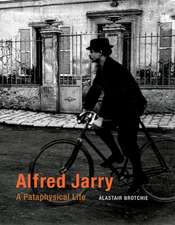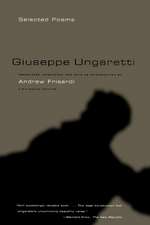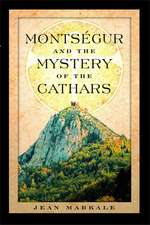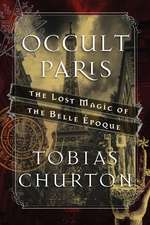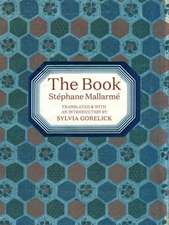Gnostic Mysteries of Sex: Sophia the Wild One and Erotic Christianity
Autor Tobias Churtonen Limba Engleză Paperback – 10 sep 2015
Churton explores the practices of the "first Gnostic," the historical Simon Magus, and explains the vital significance of "the seed" in Gnostic practice, showing it to be the sacramental substance par excellence. He illuminates the suppressed truth of why the name "Valentine" came to be associated with ennobling erotic love and reveals profound parallels between sexual gnosis and Tantra, suggesting that gnosis lies at the root of the tantric path.
Solving a millennia-old riddle regarding the identity and secret symbol of Sophia, the mysterious Gnostic "Aeon," Churton investigates Sophia's connections to Barbelo, also known as Pruneikos, the Wild Lady of Wisdom, and the central focus of the Barbelo Gnostics of the 2nd century, whose religious sex practices so shocked orthodox Christian contemporaries that they were condemned, their cults of spiritual gnosis and "redemption by sin" driven underground.
Churton exposes the mystery of Sophia in the philosophy of the medieval Troubadours and explores William Blake's inheritance of secret Renaissance sexual mysticism through the revolutionary English poet Andrew Marvell. Showing how Blake's sexual and spiritual revolution connects to modern sexual magic, Churton also examines the esoteric meaning of the free-love explosion of the 1960s, revealing how sex can be raised from the realm of guilt into the highest magical sacrament of spiritual transformation.
Preț: 80.23 lei
Preț vechi: 97.45 lei
-18% Nou
15.35€ • 15.94$ • 12.80£
Carte disponibilă
Livrare economică 07-19 martie
Specificații
ISBN-10: 1620554216
Pagini: 320
Dimensiuni: 152 x 229 x 23 mm
Greutate: 0.52 kg
Editura: Inner Traditions/Bear & Company
Colecția Inner Traditions
Notă biografică
Tobias Churton is Britain’s leading scholar of Western Esotericism, a world authority on Gnosticism, Hermeticism, and Rosicrucianism. An Honorary Fellow of Exeter University, where he is faculty lecturer in Rosicrucianism and Freemasonry, he holds a master’s degree in Theology from Brasenose College, Oxford, and is the author of many books, including Gnostic Philosophy, The Invisible History of the Rosicrucians, and Aleister Crowley: The Beast in Berlin. He lives in England.
Extras
Be My Valentine
The association between the Gnostic teacher Valentinus with what we call romantic love is both ancient and profound and testifies not only to extremely rare evidence for the genuine Gnostic presence in Rome in the third century, but to a spiritual love bond that characterizes couples who have embraced a Gnostic conception of everlasting love.
We tend to take romantic love for granted, but it was not always so. Marriage was, and still is in many parts of the world, primarily an arrangement of property both in what the wife brought to the husband’s estate, and the husband to the wife’s family, and the disposition of the woman herself, as the husband’s “property.” The longing of love that typifies romantic dreams was primarily a matter of adulterous or premarital life: the object of desire was often quite literally “unobtainable,” since he or she was already “promised in marriage.” In the bitterly ironic words of Sgt. Troy in Thomas Hardy’sFar from theMadding Crowd: “All romances end in marriage.”
Western culture is, however, aware of another idea of the “love unobtainable,” something remote and spiritual, an unfleshly ideal, to which lovers are called,contra mundum. This apotheosis of love appeals to the imagination and has been prized for its ability to transform the physical pleasures of “romance” into an ecstasy unfathomable, a union of souls, something rare, unspoiled by the filth and duplicities of the world: the “knowledge of the heart.”
Such a love is properly associated with an Egyptian-born poet who came to Rome in about 136 CE and caused a stir with his startling ideas and charisma during the primacy of Bishop Hyginus. A native of Phrebonis in the Nile Delta, Valentinus (ca. 100-ca. 160 CE) very nearly became bishop of Rome himself. His disappointment at being passed over was held by detractors such as Tertullian to explain Valentinus’s embarking on founding a heretical school of “gnosis falsely so-called.” Even enemies rated Valentinus’s intellect highly, while naturally denigrating intellectualism in the process.
Educated in an Alexandrian culture of Hellenized Jews, Valentinus’s followers claim that their master was also privy to a secret, inner teaching of Paul, passed on to Theudas (cf: 2 Corinthians 12:2–4) as recorded by Clement of Alexandria. According to Tertullian’sAdversus Valentinianos(IV), Valentinus eventually retired from Alexandria to Cyprus and had Bardaisan for a pupil, having already turned into teachers and developers, or perverters, of his doctrines pupils Heracleon, Ptolemy, Marcus, Theodotus, Florinus, Secundus, Colorbasus, and Axionicus. Tertullian insists, however, that only Axionicus of Antioch kept true to his master’s teaching; all the others disavowed owing anything specifically to Valentinus and objected to being called “Valentinians.” Tertullian is emphatic that among his “followers,” personal insights were regarded as revelations, signs ofgnosis. Therefore, originality and personal judgment were prized over consistency or respect for authority.
Since Valentinus’s thought is mostly known after percolation through the minds of his pupils, it is hard to know precisely what Valentinus’s own doctrine was. However, close reading of texts gives grounds for confidence that certain features, being common to all his pupils, may be regarded as inspired by their teacher.
These features include a poetic approach to philosophical questions answered through elegant mythic devices, and, perhaps above all, a seductive doctrine of celestial marriages. Furthermore, the Nag Hammadi Library has furnished us with a previously lost text--theGospel of Truth--that may be substantially identical to a text referred to by this name by Irenaeus,1 employed by Valentinians as scripture, and therefore, possibly the work of Valentinus himself. It is indeed a work of some sophisticated subtlety, authoritative in tone and fundamentally different from other Valentinian works, but that does not mean Valentinus wrote it.
In his seventieth year, the Dutch theologian and historian of Christianity Gilles Quispel (1916-2006) shared with me his considered opinion that such was Valentinus’s appeal after his death, and such the power of his “dangerous” heresy, that the Church had to invent its own “Saint Valentine” to confuse and trounce the memory and reputation of the arch-Gnostic.
Quispel’s suspicion is perfectly plausible. The figure generally accepted as “St. Valentine” is supposed to have died a martyr’s death in the mid-third century, but his name did not appear in Roman martyrologies until very late in the fifth century, over a century after the Roman Emperor Theodosius I had declared Christianity in its orthodox form the religion of the Empire, calling deviants from orthodoxy foolish madmen liable to persecution. By then, who would dare to stand up publicly for a condemned heretic? Quispel reckoned the Catholic Church “absorbed” a major rallying figure celebrated by heretics and gave the name a “romantic” connotation with the story that Catholic martyr Valentinus, whose acts, as Pope Gelasius I said in 496 CE when establishing February 14 as “his” day, “were known only to God” (that is, unrecorded in history). Legends grew that this martyr priest had married Christian couples to prevent their being drafted into the army. It would be fitting that orthodox Christian marriage would be the story to slap onto a figure that had advocated a form of Christian marriage very different from that preached by the celibate clergy of the fifth century.
The original Valentinus would probably be dismayed by the modern idea of erotic and sentimentalized love dressed up as something “romantic” when it is only lustful fascination lathered in manufactured scent and plastered with cosmetics. Spiritually minded souls know intuitively that there is love, and there is spiritual love, and spiritual love does not necessarily mean chaste in the expression of the flesh, but chaste in the intention of the heart and mind.
Spiritual eroticism involves transmutation of the lower nature through the higher magic of spiritual union. If lovers of today and tomorrow wish to bask in the light of Valentinian love, we must look forward torising in love, notfallinginto it.
Cuprins
Acknowledgments
Introduction The Gnostic Sex Book Confessio Churtonatis
Part I
THE SEX GNOSTICS
ONE--The “Filthy Gnostickes”
Great Monsters of Heresy
Is an Erotic Christian Religion Really Possible?
The Essential Myth
Androgyny
TWO--Heresy Starts in Eden: The Accusers
The Heresiologists
Clement of Alexandria
Tertullian
Hippolytus
Epiphanius
THREE--How to Be a Superman: The First Gnostic
Sex and Simon
Simon Says--According to Hippolytus
Epiphanius on Simon
FOUR--After Simon, the Deluge
Cerdo
Saturnilus
FIVE--The Dirty People
Sethians, Seed-Gatherers, and Serpent-Worshippers
Hippolytus on the Naasseni
Kundalini Gnostics?
Epiphanius on Barbeliotes and Borborites
SIX--Tantra--Remarkable Parallels
SEVEN--Be My Valentine
EIGHT--A Question of Seed
Senseless and Crack-Brained
Tertullian on the Valentinians
Clement of Alexandria and Theodotus
A New Picture of Valentinian Sex
NINE--The Valentinian Marriage
The Knowledge of the Heart
The Good Spermaritan
TEN--In Search of the Mystery of Prouneikos and Barbelo in Alexandria
Philo of Alexandria (ca. 20 BCE-ca. 50 CE)
ELEVEN--The Lascivious One
The Wild One
Part II
GNOSTIC LOVE AND THE SPIRITUAL REVOLUTION
TWELVE--All You Need Is Sophia
Return to the Troubadours
THIRTEEN--The Golden Riddle
The Golden Ball
The Coy Mistress
The Spherical Art
The Conversion of the Jews
Heaven’s Gate
Thy Heaven Doors Are My Hell Gates
Bibliography
Index
Recenzii
“In Gnostic Mysteries of Sex, Tobias Churton works to heal Western civilization’s deepest wound--the millennia-old divorce of sex and spirit. Revealed herein are the dangerous and radical sexual secrets that the Church could not eradicate, kept hidden by the occult underground through long centuries of persecution, torture, and crusade. And here is the radical message of the Gnostics, as shocking and critically important now as it was in the second century--that sex is the gateway of liberation, and the kingdom of heaven is within.”
“Churton brings to this frank and deeply insightful study a surprisingly personal and moving narrative. The late scholar of Gnosticism Ioan Couliano once said the Gnostics were the champions of free thought--asserting a freedom to explore every logical possibility of their complex demiurgic estrangement from God and nature. It’s not so surprising then that sexual metaphysics and practices in all of their permutations were explored, along with the big questions they pose, and the gnosis they transmit. As Churton observes, ‘The new heaven and new earth result from an improvement of sensual enjoyment. There was, and is, need of it.’”
“Readable and hugely informative, Churton makes a solid case that explains the Christian teachings on sex as reactive to the non-canonical texts. As Churton writes, sex is the ‘essential battleground between heresy and orthodoxy.’ I suspect this may be a totally new branch of scholarship.”
“An erudite view of a fascinating subject. Highly recommended.”
"Churton (The Mysteries of John the Baptist) takes readers on a historical tour of available writings on sexual gnosis. ...Churton's scholarship seems to be both deep and broad..."
“If you think the last word has long since been said on the subject of sex, then you need to read this book. The question of how to reconcile sex with spirituality has long preoccupied the religious culture of both East and West. Churton explores how the Gnostics had their own approach to this issue, an approach that he traces down the centuries through the Rosicrucians and the work of poets such as Andrew Marvell and William Blake. Their message, Churton shows, points the way to a glorious synthesis of the sexual and the spiritual.”
Descriere
Examining every surviving text written by heresiologists, accounts often ignored in favor of the famous Nag Hammadi Library, Tobias Churton reveals the most secret inner teaching passed down by initiated societies: the tradition of sexual gnosis--higher union with God through the sacrament of sex. Discovering actual sex practices hidden within the writings of the Church's authorities, he reconstructs the lost world of Gnostic spiritual-erotic experience as taught by initiated masters and mistresses and practiced by Christian couples seeking spiritual freedom from the world.
Churton explores the practices of the "first Gnostic," the historical Simon Magus, and explains the vital significance of "the seed" in Gnostic practice, showing it to be the sacramental substance par excellence. He illuminates the suppressed truth of why the name "Valentine" came to be associated with ennobling erotic love and reveals profound parallels between sexual gnosis and Tantra, suggesting that gnosis lies at the root of the tantric path.
Solving a millennia-old riddle regarding the identity and secret symbol of Sophia, the mysterious Gnostic "Aeon," Churton investigates Sophia's connections to Barbelo, also known as Pruneikos, the Wild Lady of Wisdom, and the central focus of the Barbelo Gnostics of the 2nd century, whose religious sex practices so shocked orthodox Christian contemporaries that they were condemned, their cults of spiritual gnosis and "redemption by sin" driven underground.
Churton exposes the mystery of Sophia in the philosophy of the medieval Troubadours and explores William Blake's inheritance of secret Renaissance sexual mysticism through the revolutionary English poet Andrew Marvell. Showing how Blake's sexual and spiritual revolution connects to modern sexual magic, Churton also examines the esoteric meaning of the free-love explosion of the 1960s, revealing how sex can be raised from the realm of guilt into the highest magical sacrament of spiritual transformation.


